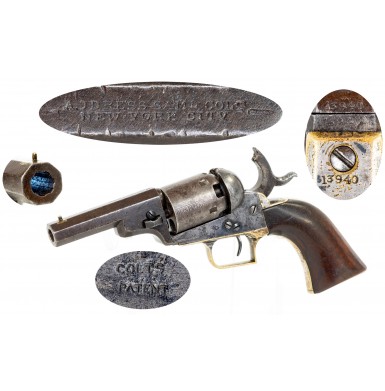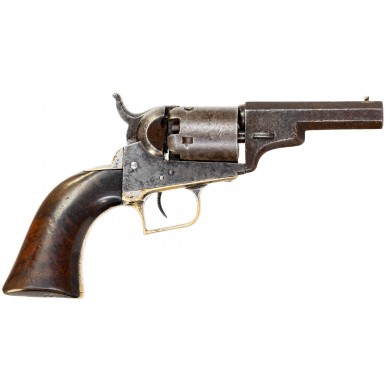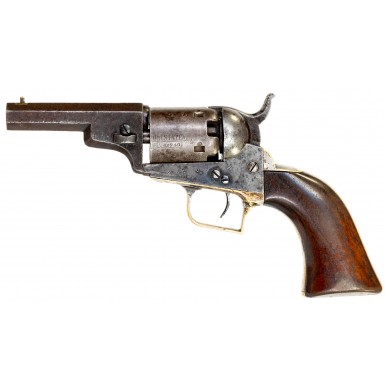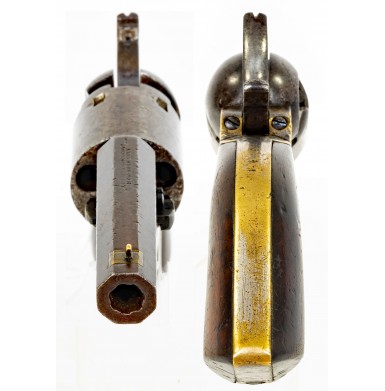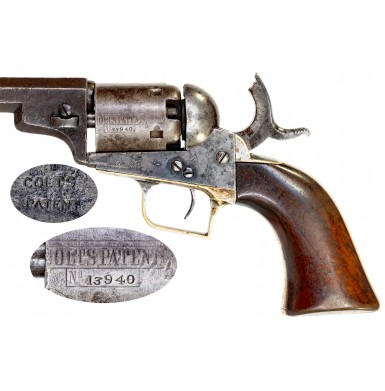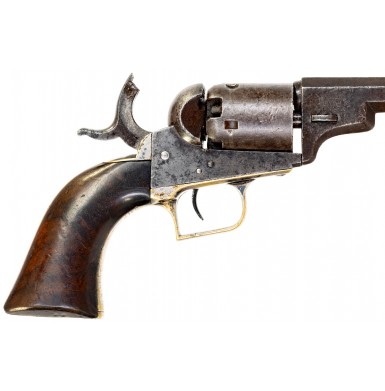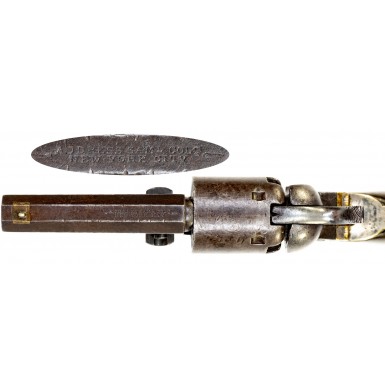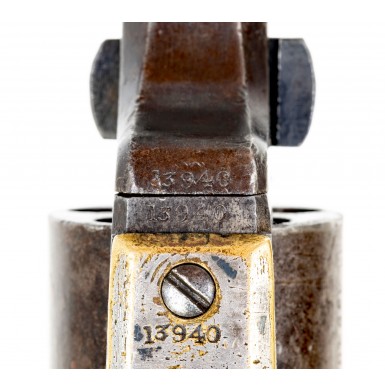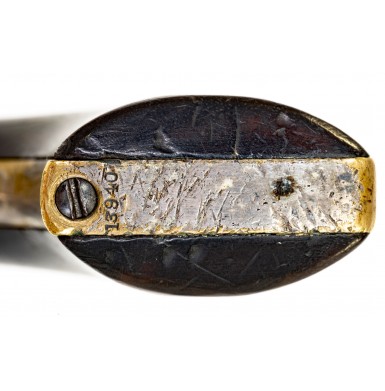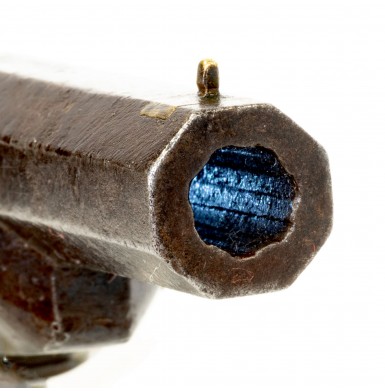Untouched Attic Condition Late Production Colt Baby Dragoon
- Product Code: FHG-3C12
- Availability: Out Of Stock
-
$2,895.00
The Colt Pocket Model of 1848, known affectionately to collectors as the Baby Dragoon was the genesis of what would become the most successful of all of Colt’s percussion revolvers, the Model 1849 Pocket Model. The Model 1848 Pocket Model went into production in Hartford sometime in 1847 and by the middle of 1850 had been completely supplanted by its successor the Model 1849 Pocket Model. During its roughly three years of the revolver’s production, about 14,000 of the diminutive handguns were produced, and a careful eye can clearly see the evolution from the “Baby Dragoon” configuration to the 1849 Pocket Model over that three-year period.
Samuel Colt had paid attention to the feedback that he received from his customers and users of his revolvers, and once the Hartford facility was up and running in 1847 producing his “Whitneyville Hartford Dragoon” Model, he quickly turned his attention to getting a pocket-sized pistol into production for civilian sale. Colt’s new design really did look like a scaled down Dragoon pattern revolver, thus the collector sobriquet “Baby Dragoon” is most appropriate. Its most instantly identifiable feature is its square backed triggerguard and the lack of a loading lever on the majority of the gun’s production. The “Baby”, as it was first produced, was a five-shot, single action percussion revolver in .31 caliber, with an octagonal barrel available in standard lengths of 3”, 4”, 5” and 6”. The 5” 1848 Pocket Model weighed a comfortable 1 pound, 6 ounces (22 ounces), fully one-third the weight of a 1st Model Dragoon, which was a hefty 4 pounds, 2 ounces (66 ounces). The majority of the Baby Dragoon production was produced without a loading lever, and the cylinder arbor pin had a concave recess to allow the arbor to serve as a loading tool when seating balls in the cylinder. The revolver was initially produced with round cylinder stops and the cylinder was roll engraved with an abbreviated version of the “Ranger & Indian Fight Scene” that that was on the cylinder of the full-sized Dragoon revolvers. Like nearly all of Colt’s percussion revolvers, the gun was of the open top construction and had a removable barrel, secured to the frame by a wedge, which passed through the end of the cylinder arbor. The backstrap and triggerguard were of silver-plated brass, and the majority of the Baby Dragoons were finished with blued barrels, cylinders and screws and color case hardened frames and hammers.
As the revolver evolved during production, several features changed, and the Baby Dragoon eventually morphed into the 1849 Pocket Model. As production continued, the round cylinder stop-slots gave way to oval slots, which eventually became rectangular, and finally became rectangular with rounded guide grooves. As the stop grooves on the cylinder evolved, so did the cylinder scene, and somewhere between serial numbers 10,400 and 10,500 the “Ranger & Indian Fight Scene” began to be replaced by the “Stagecoach Hold Up Scene”. These scenes would appear somewhat randomly through the next few hundred guns, until the “Stagecoach” scene completely supplanted the original “Ranger” scene. Another feature that changed on the cylinders was the adoption of five safety pins on the rear of the cylinder. Originally the Baby Dragoon only incorporated a single safety pin on the rear face of the cylinder, between the chambers that bracketed the “Colt’s Patent” scroll on the cylinder. Sometime around serial number 11,000, five pins began to appear. Loading levers also started to appear on some Baby Dragoon models, and somewhere around serial number 12,000 a new barrel design with an integral loading lever and a longer forcing cone began to appear on some Baby Dragoons, and this would become the standard barrel and loading lever configuration for the 1849 Pocket. About the same time a new hammer design with a roller at the base of the hammer was introduced, and started to appear occasionally, finally becoming a standard feature in the 1849 Pocket Model. In the serial number ranges of about 11,000 to 15,500 a number of odd variations began to appear, as old parts were used up, new features were added, and the final form of the Model 1849 Pocket Revolver began to appear. It is in this range that the round triggerguard began to appear, resulting in some strange feature combinations. In this serial number range, Colt was manufacturing the standard “Baby Dragoon” models, standard Model 1849 Pocket Models, as well as strange “combination models” like the “Square Back” Model 1849 Pocket (a better name in my mind than a Baby Dragoon with rammer), or a round triggerguard “Baby Dragoon” (called by some the Pre-Wells Fargo Model). Other more minor features changed as the “Baby” evolved, like the way that dashes or brackets were used around the barrel address, and in a few cases, even the orientation of the barrel address (right hand or left hand) changed. Other small changes included a reduction in the grip angle, giving the muzzle of the pistol a less pronounced upward cant in the hand, some minor changes in the internal thickness of the brass gripstrap and a change in the way the forward portion of the trigger slot was cut in triggerguard plate, from rounded to squared.
Even though the model seemed to be constantly changing and improving, the public was very receptive to the handy, reliable, and very concealable pistol. Some 2,000 of the revolvers were produced in 1847, even though the gun was only in production during the latter portion of that year. 1848 saw a substantial increase in sales, with 6,000 produced and 1849 saw another 4,000 manufactured. Many of these guns were purchased and taken west by prospectors seeking riches in the gold fields of California. The 1849 Gold Rush was a real boon to Colt’s business, and as the 1848 Pocket Model became the famous 1849 Pocket Model, sales only increased. The 1849 Pocket would eventually become the most successful civilian revolver of the era with about 331,000 units produced over slightly more than two decades. Today, the 1848 Pocket Model that started the evolution to the 1849 Pocket is a scarce and desirable collector piece and an imported gun in any Colt revolver collection. With only about 14,000 produced, the total production is quite low compared to other Colt models, and the fact that so many of the guns were taken west into the harsh conditions of the California gold fields means that the survival rate is fairly low and crisp guns that retain any original finish are extremely scarce. This makes any “Baby Dragoon” in very good or better original condition hard to find and a real coup to add to a collection.
This Colt Model 1848 Pocket Model aka Baby Dragoon is in about GOOD+, untouched, “attic” condition. The gun is 100% complete, correct, and original and has all matching serial numbers. The serial number is 13940 making it one of the very last Baby Dragoon revolvers to be produced. As such the features of the revolver classify it as a “Third Transition” model Baby Dragoon, according to Colt researcher, collector and author Sam Pachanian (see the American Society of Arms Collectors Bulletin #59 – Fall 1988). These “Third Transition” guns are found at the end of the Baby Dragoon serial number series, where the guns are interspersed with Model 1849 Pocket Revolvers. These revolvers used rectangular cylinder stop slots with guide grooves, primarily used dashed finials at the beginning and end of the barrel address, with the address oriented in the right-hand direction. These late transitional guns also eliminate the upward angle acclivity between the grip and barrel than earlier “Baby Dragoon” models, using the grip angle that would be standard for the 1849 Pocket Model. These guns also featured the “Stagecoach Hold Up” scene, the new cylinder ratchet design and the roller hammer. The revolver is in fairly crisp condition with mostly clear and legible markings throughout. The serial number 13940 is clearly stamped on the bottom of the barrel lug, on the bottom of the frame, on the bottom of the triggerguard, the bottom of the grip strap, on the side of the cylinder and on the bottom of the barrel wedge. The left side of the frame is marked in two lines:
COLTS
PATENT
and the cylinder is marked in two lines:
COLTS PATENT
No 13940
The 3” octagon barrel is marked in two lines, flanked by a pair of dashed finials:
- ADDRESS SAML COLT -
NEW-YORK CITY
The address is in the standard “Right Hand” orientation that reads from the muzzle to the frame. The revolver shows a moderate amount of real-world use but remains fairly crisp. The gun retains no real finish to speak of which is not uncommon with this pocket pistols that often saw significant use and carry in somewhat harsh condition. The gun has a rich, untouched, and moderately oxidized brown patina with some strong traces of blue on the barrel web and some freckled hints of blue here and there on the barrel. The frame is a mottled gray color with scattered patches of darker patina that hint at the original case coloring. This has mixed with flecks and patches of age discoloration, as well as some minute traces of dulled and faded colors. The barrel is partly smooth but does show some scattered areas of oxidized surface roughness, pinpricking and some light pitting scattered along its entire length. The bore of the revolver is in about GOOD condition. It is dark and heavily oxidized with strong rifling present its entire length. The bore shows moderate pitting along its entire length as well. The cylinder retains about 50%+ of its “Ranger & Indian Fight Scene” and has a medium pewter gray patina with a thin brown haze of oxidation forming, and scattered patches of darker oxidized discoloration and minor surface etching present. These areas of darker oxidation and minor pitting are most prevalent around the front of the cylinder near the chamber mouths and around the percussion cone recesses. The cones (nipples) are all original and they all show moderate wear, as well as the expected moderate to heavy pitting and oxidation from use in their recesses. The original single safety pins are all worn away and show only the trace remnants of their existence on the rear face of the cylinder. The front sight is a dovetailed brass blade that has been filed down to more of a narrow post than a blade. The front sight is certainly non-standard but is so old and clearly been with the revolver so long that it is definitively from the period of use, and may be a factory original dovetailed sight. The action of the pistol is in VERY GOOD condition, and it functions correctly on all positions. The revolver indexes, times and locks up exactly as it should. The brass backstrap, gripstrap and triggerguard all retain some of traces their original silver plating, with the amounts varying from traces to as much as 10% or maybe 20% in some areas. Much of the remaining silver has tarnished to a dark gray color. The screw heads all remain in reasonably good condition, with only most showing light to moderate slot wear. The one-piece walnut grip remains in about GOOD+ condition as well. The grip is more figured than the typical walnut grip and is solid and complete. The grip is free of any breaks, cracks, or repairs. The grip does not appear to retain any of its original varnish, but that is typical of a Baby Dragoon that was carried a lot and saw some moderate use. The grip shows scattered bumps, dings and handling marks, and have some light wear at the sharp leading and trailing edges but show no abuse or any real damage. The grip may have been lightly sanded at some point in time.
Overall, this is a nice, solid example of an 1850 production Colt Model 1848 Pocket Model aka “Baby Dragoon”. The gun is in better condition than many of the examples encountered today and has not been cleaned to death or had the cylinder scene polished off of it. The revolver is all matching, including the wedge. The gun is 100% complete and correct and shows all the indications of real world carry and use, with no abuse. This is one of those guns that you wish could talk as it was produced the year after the Gold Rush of 1849 and quite possibly traveled west with an owner searching for his fortune. Clearly the revolver was fired quite a bit during its life, which is why there is so much pitting and wear around the cones (nipples) and why there is flash erosion and etching on the cylinder and in the bore. Even though the gun saw at least moderate use, it was clearly well cared for and may well have helped its owner escape a close call or two. This would be a nice addition to your collection of Colt revolvers, as this is a crisp, well-marked and “no excuses” example of the desirable “Baby Dragoon”. I am quite sure that you will be glad to add this “Baby” to your collection of 19th century percussion revolvers and will be very proud to display it.
SOLD
Tags: Untouched, Attic, Condition, Late, Production, Colt, Baby, Dragoon

